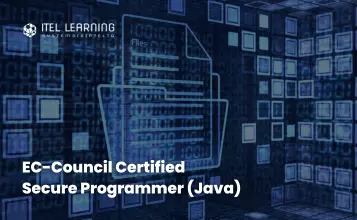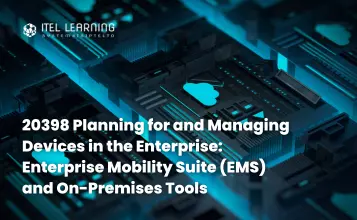Overview
Today, Java is embedded in 3 billion devices from laptops and super computers to game consoles, mobile phones, etc. Java is widely adopted because of its ability to be a platform and architecture independent characteristic that encourages developers and industry alike.
ITEL provides a 3-day comprehensive hands-on course which covers topics on Java security features, policies, strengths and weaknesses. This course helps the participants to understand how to write secure and robust Java applications and provides advanced knowledge in various aspects of secure Java development that can effectively prevent hostile and buggy code. This results in saving valuable effort, money, time, and possibly the reputation of organization using Java-coded applications.
Prerequisites
Participants who wish to take up EC-Council Certified Secure Programmer (Java) must be well-versed in Java programming language.
Who Should Attend?
The ECSP Java Certification is tailored for programmers who are responsible for designing and building secure Windows/Web based applications with Java. It is designed for developers who have Java development skills.
Course Outline
- Vulnerability Disclosure Growth by Year 2001-2011
- Impact of Vulnerabilities and Associated Costs
- Security Incidents: 2011
- Software Security Failure Costs
- Need for Secure Coding
- Java Security Overview
- Java Security Platform
- Sandbox
- Java Virtual Machine (JVM)
- Class Loading
- Bytecode Verifier
- Class Files
- Security Manager
- Java Security Policy
- Java Security Framework
- Java Authentication and Authorization Service(JAAS)
- Java Secure Socket Extension (JSSE)
- Java Generic Security Service API (JGSS)
- Simple Authentication and Security Layer API (Java SASL API)
- Why Secured Software Development is needed?
- Why Security Bugs in SDLC?
- Characteristics of a Secured Software
- Security Enhanced Software Development Life Cycle
- Software Security Framework
- Secure Architecture and Design
- Design Principles for Secure Software Development
- Guidelines for Designing Secure Software
- Threat Modeling
- Threat Modeling Approaches
- Web Application Model
- Threat Modeling Process
- Security Objectives
- Application Overview
- Application Decomposition
- Identify Threats
- Identify and Prioritize Vulnerabilities
- SDL Threat Modeling Tool
- Secure Design Considerations
- Secure Java Patterns and Design Strategies
- Secure Java Coding Patterns
- Secure Code Patterns for Java Applications
- Secure Coding Guidelines
- System Quality Requirements Engineering
- System Quality Requirements Engineering Steps
- Software Security Testing
- Security Testing Objectives
- Types of Security Testing
- Prerequisites for Security Testing
- Software Security Testing at Every Phase of SDLC
- Security Testing Web Applications
- Secure Code Review
- Step 1: Identify Security Code Review Objectives
- Step 2: Perform Preliminary Scan
- Step 3: Review Code for Security Issues
- Step 4: Review for Security Issues Unique to the Architecture
- Code Review
- Input Validation and XSS
- Buffer Overflow and Command Injection
- SQL Injection
- Exception Handling and Authentication
- Session Management and Cookie Management
- Denial-of-Service
- Source Code Analysis Tools
- Advantages and Disadvantages of Static Code Analysis
- Advantages and Disadvantages of Dynamic Code Analysis
- LAPSE: Web Application Security Scanner for Java
- FindBugs: Find Bugs in Java Programs
- Coverity Static Analysis
- Coverity Dynamic Analysis
- Veracode Static Analysis Tool
- Source Code Analysis Tools For Java
- Fuzz Testing
- File Input and Output in Java
- The java.io package
- Character and Byte Streams in Java
- Reader and Writer
- Input and Output Streams
- All File creations should Accompany Proper Access Privileges
- Handle File-related Errors cautiously
- All used Temporary Files should be removed before Program Termination
- Release Resources used in Program before its Termination
- Prevent exposing Buffers to Untrusted Code
- Multiple Buffered Wrappers should not be created on a single InputStream
- Capture Return Values from a method that reads a Byte or Character to an Int
- Avoid using write() Method for Integer Outputs ranging from 0 to 255
- Ensure Reading Array is fully filled when using read() Method to Write in another Array
- Raw Binary Data should not be read as Character Data
- Ensure little endian data is represented using read/write methods
- Ensure proper File Cleanup when a Program Terminates
- Ensure Sensitive Log Information is not Leaked outside a Trust Boundary
- File Input/Output Best Practices
- File Input and Output Guidelines
- Serialization
- Implementation Methods of Serialization
- Maintain Compatible Serialization Form
- Use Proper Signatures Methods
- Avoid Serializing Sensitive and Unencrypted Data
- Perform Security Manager Checks
- Avoid Serialization of Inner classes
- Maintain a copy of Private Mutable Components while Deserialization
- Avoid Calling Overridable Methods
- Prevent Memory or Resource Leaks
- Avoid Overwriting of Externalizable Objects
- Serialization Best Practices
- Secure Coding Guidelines in Serialization
- Percentage of Web Applications Containing
- Input Validation Vulnerabilities
- Input Validation Pattern
- Validation and Security Issues
- Impact of Invalid Data Input
- Data Validation Techniques
- Whitelisting vs. Blacklisting
- Input Validation using Frameworks and APIs
- Regular Expressions
- Vulnerable and Secure Code for Regular Expressions
- Servlet Filters
- Struts Validator
- Struts Validation and Security
- Data Validation using Struts Validator
- Avoid Duplication of Validation Forms
- Secure and Insecure Struts Validation Code
- Struts Validator Class
- Secure and Insecure Code for Struts Validator Class
- Enable the Struts Validator
- Secure and Insecure Struts Validator Code
- Check for Similar Number of Fields in Action Form and Validation Form
- Secure Code that Implements Similar Number of Fields in Action Form and Validation Form
- HTML Encoding
- Vulnerable and Secure Code for HTML Encoding
- Prepared Statement
- Vulnerable and Secure Code for Prepared Statement
- CAPTCHA
- Sample Code for Creating CAPTCHA
- Sample Code for CAPTCHA Verification
- Sample Code for Displaying CAPTCHA
- Stored Procedures
- Vulnerable and Secure Code for Stored Procedures
- Stored Procedure for Securing Input Validation
- Character Encoding
- Vulnerable and Secure Code for Character Encoding
- Checklist for Character Encoding
- Input Validation Errors
- Improper Sanitization of Untrusted Data
- Improper Validation of Strings
- Improper Logging of User Inputs
- Improper Incorporation of Malicious Inputs into Format Strings
- Inappropriate use of Split Characters in Data Structures
- Improper Validation of Non-Character Code Points
- Best Practices for Input Validation
- Exception and Error Handling
- Example of an Exception
- Handling Exceptions in Java
- Exception Classes Hierarchy
- Exceptions and Threats
- Erroneous Exceptional Behaviors
- Suppressing or Ignoring Checked Exceptions
- Disclosing Sensitive Information
- Logging Sensitive Data
- Restoring Objects to Prior State, if a method fails
- Avoid using Statements that suppress Exceptions
- Prevent Access to Untrusted Code that terminates JVM
- Never catch java.lang.NullPointerException
- Never allow methods to throw RuntimeException, Exception, or Throwable
- Never throw Undeclared Checked Exceptions
- Never let Checked Exceptions escape from Finally Block
- Do’s and Don’ts in Exception Handling
- Best Practices for Handling Exceptions in Java
- Logging in Java
- Example for Logging Exceptions
- Logging Levels
- Log4j and Java Logging API
- Java Logging using Log4j
- Vulnerabilities in Logging
- Logging: Vulnerable Code and Secure Code
- Secured Practices in Logging
- Percentage of Web Applications Containing
- Authentication Vulnerabilities
- Percentage of Web Applications Containing Authorization Bypass Vulnerabilities
- Introduction to Authentication
- Java Container Authentication
- Authentication Mechanism Implementation
- Declarative v/s Programmatic Authentication
- Declarative Security Implementation
- Programmatic Security Implementation
- Java EE Authentication Implementation Example
- Basic Authentication
- How to Implement Basic Authentication?
- Form-Based Authentication
- Form-Based Authentication Implementation
- Implementing Kerberos Based Authentication
- Secured Kerberos Implementation
- Configuring Tomcat User Authentication Setup
- Client Certificate Authentication in Apache Tomcat
- Client Certificate Authentication
- Certificate Generation with Keytool
- Implementing Encryption and Certificates in Client Application
- Authentication Weaknesses and Prevention
- Brute Force Attack
- Web-based Enumeration Attack
- Weak Password Attacks
- Introduction to Authorization
- JEE Based Authorization
- Access Control Model
- Discretionary Access Control (DAC)
- Mandatory Access Control (MAC)
- Role-based Access Control (RBAC)
- Servlet Container
- Authorizing users by Servlets
- Securing Java Web Applications
- Session Management in Web Applications
- EJB Authorization Controls
- Declarative Security with EJBs
- Programmatic Security with EJBs
- Common Mistakes
- Java Authentication and Authorization (JAAS)
- JAAS Features
- JAAS Architecture
- Pluggable Authentication Module (PAM) Framework
- JAAS Classes
- JAAS Subject and Principal
- Authentication in JAAS
- Authentication Steps in JAAS
- Authorization in JAAS
- Authorization Steps in JAAS
- Subject Methods doAs() and doAsPrivileged()
- Impersonation in JAAS
- JAAS Permissions
- LoginContext in JAAS
- Creating LoginContext
- LoginContext Instantiation
- JAAS Configuration
- Locating JAAS Configuration File JAAS CallbackHandler and Callbacks
- Login to Standalone Application
- JAAS Client
- LoginModule Implementation in JAAS
- Methods Associated with LoginModule
- LoginModule Example
- Phases in Login Process
- Java EE Application Architecture
- Java EE Servers as Code Hosts
- Tomcat Security Configuration
- Best Practices for Securing Tomcat
- Declaring Roles
- HTTP Authentication Schemes
- Securing EJB
- Percentage of Web Applications Containing a Session Management Vulnerability
- Java Concurrency/Multithreading
- Concurrency in Java
- Different States of a Thread
- Java Memory Model: Communication between Memory of the Threads and the Main Memory
- Creating a Thread
- Extending the java.lang.Thread Class
- Implementing the java.lang.Runnable Interface
- Thread Implementation Methods
- Threads Pools with the Executor Framework
- Concurrency Issues
- Do not use Threads Directly
- Avoid calling Thread.run() Method directly
- Use ThreadPool instead of ThreadGroup
- Use notifyall() for Waiting Threads
- Call await() and wait() methods within a Loop
- Avoid using Thread.stop()
- Gracefully Degrade Service using Thread Pools
- Use Exception Handler in Thread Pool
- Avoid Overriding Thread-Safe Methods with the non Thread-Safe Methods
- Use this Reference with caution during Object Construction
- Avoid using Background Threads while Class Initialization
- Avoid Publishing Partially Initialized Objects
- Race Condition
- Secure and Insecure Race Condition Code
- Deadlock
- Avoid Synchronizing high level Concurrency Objects using Intrinsic Locks
- Avoid Synchronizing Collection View if the program can access Backing Collection
- Synchronize Access to Vulnerable Static fields prone to Modifications
- Avoid using an Instance Lock to Protect Shared Static Data
- Avoid multiple threads Request and Release Locks in Different Order
- Release Actively held Locks in Exceptional Conditions
- Ensure Programs do not Block Operations while Holding Lock
- Use appropriate Double Checked Locking Idiom forms
- Class Objects that are Returned by getClass() should not be Synchronized
- Synchronize Classes with private final lock Objects that Interact with Untrusted Code
- Objects that may be Reused should not be Synchronized
- Be Cautious while using Classes on Client Side that do not Stick to their Locking Strategy
- Deadlock Prevention Techniques
- Ordering of Locks
- Lock Timeout
- Deadlock Detection
- Secured Practices for Handling Threads
- Session Management
- Session Tracking
- Session Tracking Methods
- Cookies
- URL Rewriting
- Hidden Fields
- Session Objects
- Session Vulnerabilities
- Types of Session Hijacking Attacks
- Countermeasures for Session Hijacking
- Countermeasures for Session ID Protection
- Best Coding Practices for Session Management
- Checklist to Secure Credentials and Session IDs
- Guidelines for Secured Session Management
- Percentage of Web Applications Containing
- Encryption Vulnerabilities
- Need for Java Cryptography
- Java Security with Cryptography
- Java Cryptography Architecture (JCA)
- Java Cryptography Extension (JCE)
- Attack Scenario: Inadequate/Weak Encryption
- Encryption: Symmetric and Asymmetric Key
- Encryption/Decryption Implementation Methods
- SecretKeys and KeyGenerator
- Implementation Methods of KeyGenerator Class
- Creating SecretKeys with KeyGenerator Class
- Key Generation Tool: RSA Key Generation Utility
- The Cipher Class
- Implementation Methods of Cipher Class
- Insecure Code for Cipher Class using DES Algorithm
- Secure Code for Cipher Class using AES Algorithm
- Attack Scenario: Man-in-the-Middle Attack
- Digital Signatures
- The Signature Class
- Implementation Methods of Signature Class
- The SignedObjects
- Implementing Methods of SignedObjects
- The SealedObjects
- Implementation Methods of SealedObject
- Insecure and Secure Code for Signed/Sealed Objects
- Digital Signature Tool: DigiSigner
- Secure Socket Layer (SSL)
- Java Secure Socket Extension (JSSE)
- SSL and Security
- Example 1
- Example 2
- JSSE and HTTPS
- Insecure HTTP Server Code
- Secure HTTP Server Code
- Attack Scenario: Poor Key Management
- Keys and Certificates
- Key Management System
- KeyStore
- Implementation Method of KeyStore Class
- KeyStore: Temporary Data Stores
- Secure Practices for Managing Temporary Data Stores
- KeyStore: Persistent Data Stores
- Key Management Tool: KeyTool
- Digital Certificates
- Certification Authorities
- Signing Jars
- Signing JAR Tool: Jarsigner
- Signed Code Sources
- Insecure Code for Signed Code Sources
- Secure Code for Signed Code Sources
- Code Signing Tool: App Signing Tool
- Java Cryptography Tool: JCrypTool
- Java Cryptography Tools
- Do’s and Don’ts in Java Cryptography
- Avoid using Insecure Cryptographic Algorithms
- Avoid using Statistical PRNG, Inadequate Padding and Insufficient Key Size
- Implement Strong Entropy
- Implement Strong Algorithms
- Best Practices for Java Cryptography
- Average Number of Vulnerabilities Identified within a Web Application
- Computers reporting Exploits each quarter in 2011, by Targeted Platform or Technology
- Introduction to Java Application
- Java Application Vulnerabilities
- Cross-Site Scripting (XSS)
- Cross-Site Scripting (XSS) Countermeasures
- Cross Site Request Forgery (CSRF)
- Cross Site Request Forgery (CSRF) Countermeasures
- Directory Traversal
- Directory Traversal Countermeasures
- HTTP Response Splitting
- HTTP Response Splitting Countermeasures
- Parameter Manipulation
- Parameter Manipulation and Countermeasures
- XML Injection
- SQL Injection
- Command Injection
- LDAP Injection
- XPATH Injection
- Injection Attacks Countermeasures








